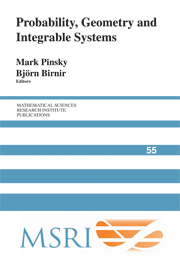Book contents
- Frontmatter
- Contents
- Preface
- Henry McKean: A tribute by the editors
- Bitangential direct and inverse problems for systems of differential equations
- Turbulence of a unidirectional flow
- Riemann–Hilbert problem in the inverse scattering for the Camassa–Holm equation on the line
- The Riccati map in random Schrödinger and random matrix theory
- SLE6and CLE6 from critical percolation
- Global optimization, the Gaussian ensemble, and universal ensemble equivalence
- Stochastic evolution of inviscid Burgers fluid
- A quick derivation of the loop equations for random matrices
- Singular solutions for geodesic flows of Vlasov moments
- Reality problems in the soliton theory
- Random walks and orthogonal polynomials: some challenges
- Integration of pair flows of the Camassa–Holm hierarchy
- Landen Survey
- Lines on abelian varieties
- Integrable models of waves in shallow water
- Nonintersecting Brownian motions, integrable systems and orthogonal polynomials
- Homogenization of random Hamilton–Jacobi–Bellman Equations
Turbulence of a unidirectional flow
Published online by Cambridge University Press: 27 June 2025
- Frontmatter
- Contents
- Preface
- Henry McKean: A tribute by the editors
- Bitangential direct and inverse problems for systems of differential equations
- Turbulence of a unidirectional flow
- Riemann–Hilbert problem in the inverse scattering for the Camassa–Holm equation on the line
- The Riccati map in random Schrödinger and random matrix theory
- SLE6and CLE6 from critical percolation
- Global optimization, the Gaussian ensemble, and universal ensemble equivalence
- Stochastic evolution of inviscid Burgers fluid
- A quick derivation of the loop equations for random matrices
- Singular solutions for geodesic flows of Vlasov moments
- Reality problems in the soliton theory
- Random walks and orthogonal polynomials: some challenges
- Integration of pair flows of the Camassa–Holm hierarchy
- Landen Survey
- Lines on abelian varieties
- Integrable models of waves in shallow water
- Nonintersecting Brownian motions, integrable systems and orthogonal polynomials
- Homogenization of random Hamilton–Jacobi–Bellman Equations
Summary
We discuss recent advances in the theory of turbulent solutions of the Navier–Stokes equations and the existence of their associated invariant measures. The statistical theory given by the invariant measures is described and associated with historically-known scaling laws. These are Hack's law in one dimension, the Batchelor–Kraichnan law in two dimensions and the Kolmogorov's scaling law in three dimensions. Applications to problems in turbulence are discussed and applications to Reynolds Averaged Navier Stokes (RANS) and Large Eddy Simulation (LES) models in computational turbu-lence.
1. Introduction
Everyone is familiar with turbulence in one form or another. Airplane passengers encounter it in wintertime as the plane begins to shake and is jerked in various directions. Thermal currents and gravity waves in the atmosphere create turbulence encountered by low-flying aircraft. Turbulent drag also prevents the design of more fuel-efficient cars and aircrafts. Turbulence plays a role in the heat transfer in nuclear reactors, causes drag in oil pipelines and influence the circulation in the oceans as well as the weather.
In daily life we encounter countless other examples of turbulence. Surfers use it to propel them and their boards to greater velocities as the wave breaks and becomes turbulent behind them and they glide at great speeds down the unbroken face of the wave. This same wave turbulence shapes our beaches and carries enormous amount of sand from the beach in a single storm, sometime to dump it all into the nearest harbor. Turbulence is harnessed in combustion engines in cars and jet engines for effective combustion and reduced emission of pollutants.
Information
- Type
- Chapter
- Information
- Probability, Geometry and Integrable Systems , pp. 29 - 52Publisher: Cambridge University PressPrint publication year: 2008
